What is Gaia Project?
Gaia Project is the sequel to the highly successful Terra Mystica. But whereas Terra Mystica had a fantasy theme, Gaia Project takes place in outer space in the far future of the “Terra Mystica universe.” Players try to settle and terraform new worlds, advance their technology, create multi-planet federations, and achieve in- and end-game objectives. The player who accumulates the most Victory Points (VPs) by the end of the sixth-round wins.
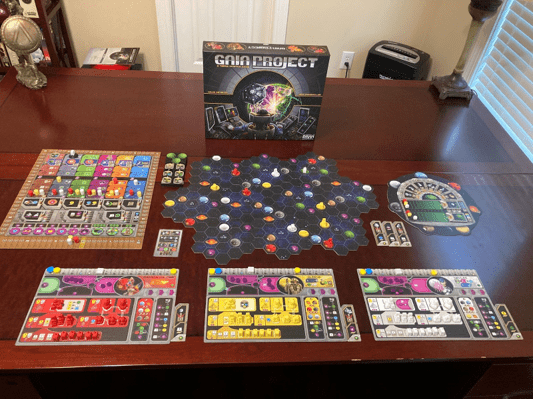
Each round of Gaia Project is played in 4 phases. During the Income Phase, players look at their Faction Board, Round Booster tile, tech tiles, and position of their Player Tokens on the Research Board. Wherever they see the palm-up hand symbol they gain those resources. In the Gaia Phase players complete any Gaiaforming operations they may have started the previous turn. The Actions Phase is the heart of the game where players take turns performing one main action. Once a player passes, they turn in their Round Booster tile and take one of the other available tiles. The first player to take the Pass action also takes the first player token. Finally, the Clean-Up Phase resets everything for the next round.
Mechanics and Features
Gaia Project combines a bunch of different systems, and while this may seem daunting to new players, all of them make sense and work together.
The Power Cycle
The Power Cycle is a unique feature of both Terra Mystica and Gaia Project. Unlike spending other types of resources, which are permanently lost when used to perform actions, spending power does not. Instead, power tokens cycle through the numbered areas on your Faction Board. When permitted to charge power, all tokens must first be moved from Area I to Area II before tokens can be moved from Area II to Area III. When players spend power, they move power tokens from Area III to Area I.

During the Income Phase, players may gain new power tokens if they see the Gain Power icon on their Faction Board. These are placed in Area I. They can also charge power when they see the Charge Power icon. During the income Phase, players can add new power tokens and charge power in any order provided one (adding or charging) is completely accomplished before the other.
So, what are Power Tokens used for? They grant players actions on the research board, as well as any they uncover on their Faction Board. They also permit players to form multi-planet Federations.
Actions
Just about every action requires spending resources (ore, credit, knowledge, power, or Q.I.Cs – Quantum Intelligence Cubes). Therefore, obtaining and managing resources is an integral part of the game. There are eight possible main actions.
- Build a Mine on a planet that is currently unoccupied by another player by spending 1 ore and 2 credits. That planet must be in range of one of your existing occupied planets and will need to be terraformed if it is not your home planet type by spending additional ore.
- Upgrade an Existing Structure by replacing an existing building with the next highest type from your Faction Board and spending the indicated amount of ore and credit. The structure replaced is put back on your Faction Board.
- Start a Gaia Project by placing an available Gaiaformer on a Transdim (purple) planet spending the required number of power tokens and placing them into the Gaiaforming area. These will move to Area I during the next Gaia phase.
-

Federation Tokens Form a Federation by placing satellite cubes in empty hexes to connect 7 power’s worth of buildings. Each Mine is worth 1 power, each trading station or research lab 2 power, and 3 for each academy or planetary institute. Each satellite placed permanently removes a power token from a player’s Faction Board. The player then gets to take a Federation token and collect the indicated number of resources and VPs.
- Research the next level of one technology by spending 4 knowledge, gaining any immediate resources indicated by a star and white outline.
- Power and Q.I.C. Actions can be selected by placing an Action Token on a Power or Q.I.C. action space that currently doesn’t have a token on it and spending the indicated number of power/Q.I.C.s.
- Special Actions can be selected by placing an Action Token on an empty orange action space the player controls, be it on a tech tile, booster tile, or their Faction Board.
- Pass when you don’t have enough resources to take another action, turn in your Round Booster, and select another.
In addition to the main actions, players can take any number of free actions before or after their main action. This includes discarding 1 power from Area II to move another power from Area II to Area III. The other free actions are shown in the lower right-hand side of the Faction Board and mostly involve spending power or resources to gain other resources.
Furthermore, players can passively charge Power Tokens when another player builds a mine or upgrades a structure within two hexes of one of their structures. Passive charging isn’t mandatory. The amount you can charge equals the power level of your structure (not the placed/upgraded by the other player). However, passive charging costs 1 fewer VPs than the power you charge. So, if you charge 2 power you will also lose 1 VP.
Building and Upgrading Structures
This is the heart of the economic engine in Gaia Project. Each structure is associated with a different resource. Mines produce ore, trading posts produce credits, and research labs produce knowledge. Academies and planetary institutes provide access to a variety of benefits depending on the selected faction. Gaining access to these resources and other benefits will allow players to perform more actions and/or more powerful actions each turn.
When a new mine is built, the left-most mine is taken off the player’s Faction Board and placed on a planet. Doing so reveals a new ore resource that becomes available in the next income phase. Likewise, when a structure is upgraded, an existing structure on a planet is returned to the right-most empty space on the Factor Board and replaced by the next higher structure available on the player’s faction board. Mines are upgraded to trading posts, trading posts are upgraded to research labs or a planetary institute, and research labs to academies.

However, updating structures come at a cost. That’s because the structure that was upgraded is returned to the player’s faction board to the right-most empty space. This covers the indicated resource. It is no longer available during the next income phase. In other words, there is a resource trade-off players must make. Upgrading structures also cost resources and will provide access to new resources at the expense of losing access to others.
The Research Board
The Research Board contains 6 technology tracks: Terraforming, Navigation, Artificial Intelligence, Gaiaforming, Economy, and Research. Advancing technologies to higher levels provide several benefits. Doing so may reduce the resource cost of certain actions, such as terraforming and Gaiaforming. It may provide one-time or on-going resource bonuses. Finally, advancing to levels 3, 4 and 5 provide end-game VPs.
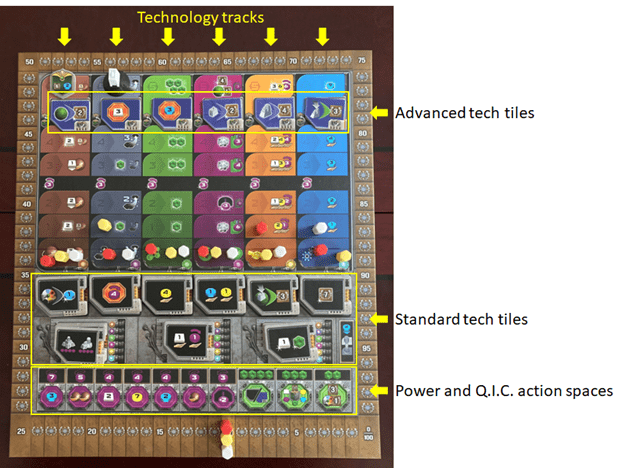
Players can advance their technology in one of two ways. As a main action they can spend 4 knowledge to advance one technology of their choice one level and immediately gain any indicated bonus. The other way to do so is to upgrade a trading post to a research lab, or a research lab to an academy. Notice the faint outline in the shape of a tech tile on the Faction Board under these structures? That means players get to select 1 of the 9 different standard tech tiles they don’t already own and put it next to their Faction Board. If they take one of the tech tiles immediately below the 6 technology tracks, they go up one level in that technology. Or they can choose one of the 3 tech tiles below and go up one level in any technology they wish.
Then there are the advanced tech tiles. If a player has formed a federation, when they advance a technology from level 4 to 5, they can flip the federation token and take the advanced tech tile plus score that federation token a second time. The advanced tech tile must be immediately placed on an existing stand tech tile, covering up its ability and replacing it with that of the advanced tech tile.
Decisions, Decisions, Decisions
Being able to plan and execute a coherent strategy is another feature of the game. This starts even before the first round when players decide which faction to choose. First, you’ll need to consider which Round and Final Scoring tiles are in play. For example, if one of the Final Scoring tiles is for owning the most structures that are part of federations, then selecting the Ambas might be a good choice since they can swap the location of their Planetary Institute and a Mine. That makes it easier to create federations. And more federations mean more Federation Tokens which generate resources and VPs.
On the other hand, if there are several Round Scoring tiles out that award VPs for placing out structures, then choosing the Hadsch Hallas might make sense. That’s because they start on Level 1 of the Economy technology track. Advancing further on that track will rake in lots of resources during each Income Phase. Plus, once they build their planetary institute, they can spend credits instead of power to take free actions to gain even more resources. With all those resources, they can do a lot of building.
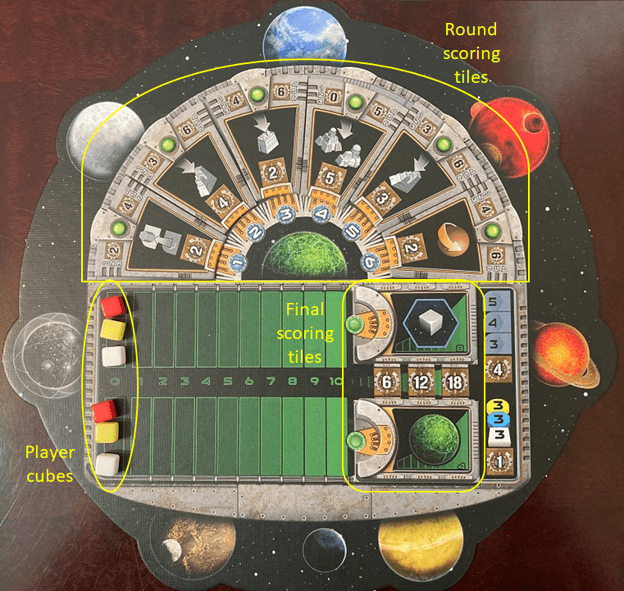
Another key decision is selecting which technologies to focus on. There are simply not enough rounds and actions in the game to advance on all 6 technology tracks. Instead, players should focus on 2 or 3. Why? Because you earn 4 VPs at the end of the game for each level 3, 4, and 5 technology level you’ve reached. And if you’ve formed a federation and advanced to level 5, you can flip one of your Federation Token to score it again. Additionally, certain technologies are better suited for achieving certain Final Scoring objectives. For instance, if one of the Final Scoring tiles is the one for colonizing the most different planet types, then it’s critical you advance your Terraforming technology. But if the Final Scoring tile that rewards colonizing planets in the most different sectors is in play, then you’ll want to give priority to advancing your Navigation technology because it makes it easier to reach those sectors.
Summary
There’s a lot to like about Gaia Project. Let’s begin with replayability. Between the modular board, the 14 different factions, and the number of different Booster, Round Scoring, and Final Scoring tiles, no two games will ever play out the same way. That’s because your actions will be dictated by which Round and Final Scoring tiles are in play and the faction you selected since each has their own strengths and weaknesses. Indeed, even what factions the other players have selected will impact how the game plays out. For example, players may find themselves competing for the same resources or planet types and have to adjust their strategy accordingly.
Since players can take their income simultaneously and are limited to a single main action on their turn means there is little down-time (barring any analysis-paralysis). That means games move quickly and do not outstay their welcome. In fact, I often wish there was just one more round in the game so I can eke out those last few VPs.
The interconnectedness of the game’s many systems and mechanics make for an interesting and challenging gaming experience. New players may feel overwhelmed initially by all the choices, but the concepts are actually relatively simple. Players will also appreciate the game’s iconography which makes it unnecessary to constantly refer to the rules.
There are no complaints about the components. The stock used for the boards and tiles is sufficiently thick to prevent warping. These are supplemented with plastic pieces for the structures, Player Tokens, Satellites, Power Tokens, and Q.I.C.s. The copiously illustrated 24-page rulebook is laid out logically and includes appendices that explain all the tiles and action spaces, as well as the unique abilities of each race/faction. The game also comes with a set of cards and rules for a solo mode.
As for negatives, I have only two quibbles. Setup and tear-down takes a while given all the different boards, tiles, and other components. The second is the lack of an insert to organize all the components. Fortunately, I purchased an insert (there are several available from Etsy) which helped alleviate both issues.
For all of these reasons, Gaia Project is one of my favorite games. So, if you’re looking for a moderately complex Euro-style game with high replay value and lots of brain-burning decisions, consider adding it to your collection. But perhaps you’re asking yourself, “Should I buy Terra Mystica instead of Gaia Project?” The games are very similar and offer comparable gaming experiences. It really comes down to a matter of taste. If you prefer fantasy-themed games over sci fi, then Terra Mystica may be more to your liking. It also has several expansions; however, there is an expansion for Gaia Project in the works.
Like I said, decisions, decisions, decisions.




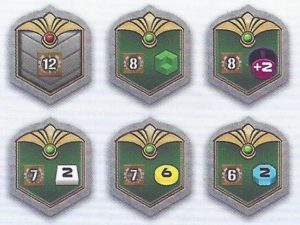



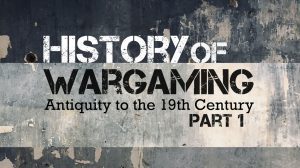




Add Comment